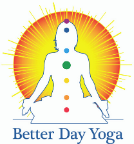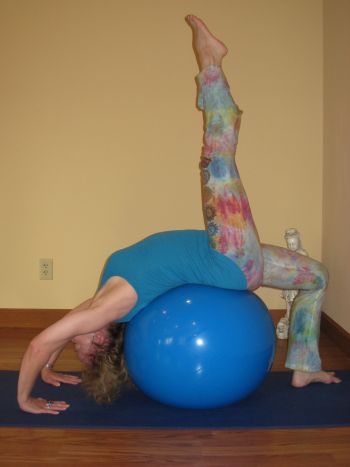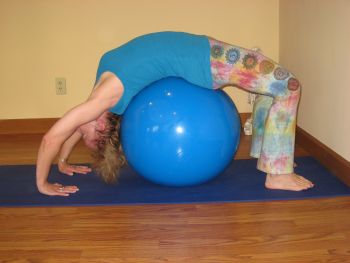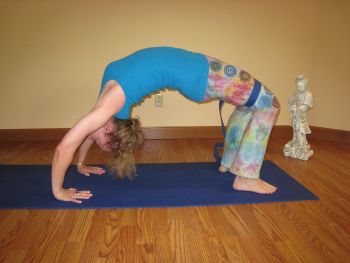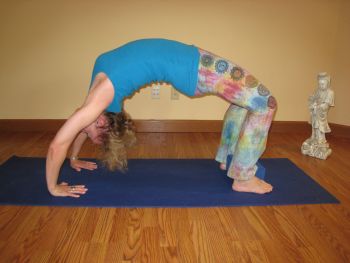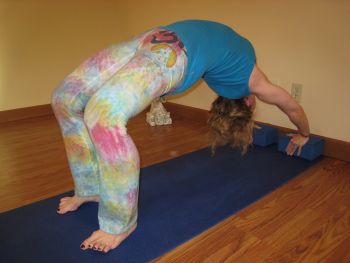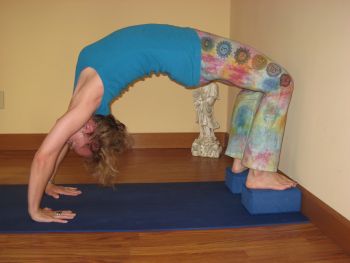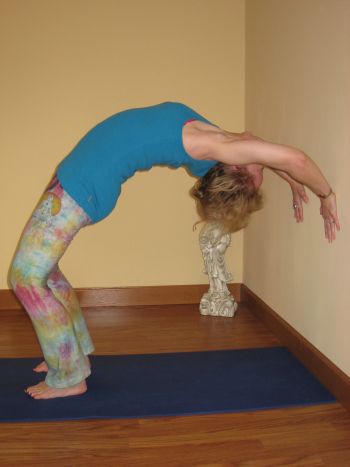
I chose this pose for obvious reasons—the focus on this issue is the circle! Full disclosure—I don’t cue wheel in my classes; and in my personal practice, I typically use a fitness ball as a prop for my first wheel and then progress to not using a prop. It is not a pose to be taken lightly and requires experience and practice to be done safely. Given that low back issues are common, I err on the side of caution.
That being said, if wheel pose is already in your practice, remember to always warm up prior to attempting any backbend! Practice in a series of poses in order to work up to wheel, such as, sphinx, cobra, camel, updog (another pose I don’t cue as part of my desire to err on the side of caution—too many “dump” into the low back here), supported standing backbend, bow, and bridge. Work with the upper back first (sphinx or cobra) and progress to the center and low back with the others.
Benefits:
- Strengthens: Glutes, hamstrings, lower back, upper back, shoulders, arms, wrists
- Stretches: Hip Flexors, abs, chest, shoulders, lungs
- Stimulates thyroid and pituitary
- Improves your mood
- Energizes the nervous system
- Increases flexibility of the spine and chest
- Improves circulation
- Beneficial for asthma and back pain
Energetic Benefits:
- Wheel stimulates all the chakras. The main energetic stimulation is on the heart chakra—opening your heart to the world and your solar plexus chakra—your identity and power chakra.
Alignment cues:
After bridge pose, place hands on either side of your head. Fingers are pointing toward the feet. Feet are flat on the floor hip-width apart. I have seen various cues for how to position the feet. I’ve been cued to have the outer edges of the feet parallel to the edges of the mat like mountain pose. Judith Hanson Lasater, Ph.D., P.T. cues the toes turned inward in her book, Yoga Body. Anatomy, Kinesiology, and Asana. Yoga Journal cues to “keep your thighs and inner feet parallel”. http://www.yogajournal.com/poses/473
I think it’s important to keep your knees going in the same direction as your toes. It’s most important to have knee comfort and safety. So feet hip distance apart with knees and toes aligned is what I focus on. Press through your hands to lift your head, shoulders, and butt off the floor while pushing feet firmly into the floor. Pause. Straighten your arms first, and then your legs, as you bring your body into an arch. Elbows are turned in on the rise. Keep your neck relaxed. Release your low back. Internally rotate both your thighs and your shoulders. Release your head down.
Focus on stretching the front of your body without struggle or strain. Keep the front of your body relaxed with the abdominal muscles passive so you can breathe softly. Use the strength from the back of your body.
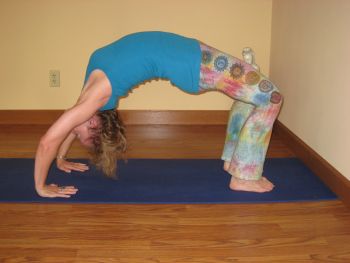
To come out, tuck your chin and place the back of your head on the mat as you lower your back to the mat.
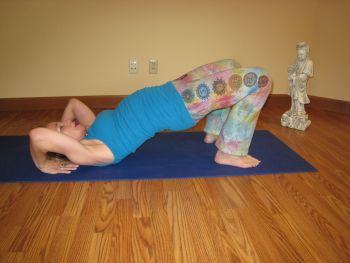
Important counterpose: Lay flat in neutral after the pose for as long as you were in the pose. I’ve been cued to do a supine butterfly pose bringing the soles of your feet together as your knees open out to release the low back. So I show both below. Your back is precious—take care which counterpose you choose!


Read the following excerpt from Yoga Journal online for more tips:
“Pose/Counterpose
A somewhat similar and traditional approach to sequencing is to follow some poses with their opposite movement. Most often, the concept of pose/counterpose involves practicing a forward bend after a backbend. In all my years of teaching, I have never heard students request backbends after forward bends, only the other way around.
With only a few limited exceptions, I prefer not to practice or teach using this approach; instead, I like to examine what I am doing in my backbend that makes me feel as though I need to immediately practice a forward bend. Such an urge makes me suspicious that I am compressing my spine unevenly in the backbend. Rather than jumping to practice a forward bend to undo the side effects of an uneven backbend, I attempt to discover exactly where and how I am compressing my back and to relieve that compression. I do, however, make an exception when I am teaching beginning students. Sometimes after backbends I will give beginners a little bit of a forward stretch, such as Downward-Facing Dog….
The main point to remember about pose/counterpose sequencing is that the best counterpose to a backbend is not a forward bend; instead, it is to do a lesser backbend. Most students seem to find that a lesser backbend is a relief, and it also does not strain the structures of the back as moving from an extreme backbend into a forward-bending movement can do. A couple of simpler backbends after a deep backbend practice feel great.
After several Urdhva Dhanurasanas (wheel), I sometimes have students just lie flat on the floor on their backs, with legs straight, and their arms over their heads and resting on the floor. This position is still an extension or backbending movement for the spine, but it is also, of course, less of a backbend than the previous pose. From this pose, you can easily and comfortably do a supine twist or another supine pose like Supta Padangusthasana (Reclining Hand-to-Big-Toe Pose).
Always remember to pay attention to the effects of a pose before you choose the next pose. If you choose a counterpose, be careful not to move to the most extreme opposite movement right away. Instead, proceed gradually toward that movement, using several intermediate movements to get there.”
Source: The Yoga Journal link / post I quoted above is unavailable as I update this in 2023. Another similar article is here.
Modification/Beginners: To build strength, keep your elbows bent and only come to the top of your head. Keep all your weight on your hands and feet—not your head and neck. Practice several “push-ups”, making each a bit higher than previous.
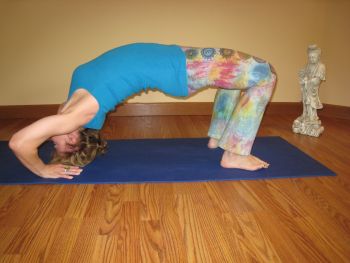
Advanced variations:
- One legged wheel / Eka Pada Urdhva Dhanurasana: As I explained earlier, I like to use an exercise ball as a prop and for this advanced version, I use the ball. Exhale and lift right knee in toward chest. Inhale and extend the right leg toward the sky. Hold 5-10 seconds, exhale, bend the knee and return the foot to the floor, perpendicular to the floor. Repeat other side.

- Chakrasana: Similar to the original pose, except that in this pose, you walk your hands to your feet and grasp your ankles—definitely NOT in my practice so not shown! The connected hands and feet makes the body appear as a circle or wheel. “This circle represents the completion of our internal energy circuit, which begins at the energy center that is located at the base of the spine and ends at the energy center at the crown of the head.” Myths of the Asanas. The stories at the heart of the yoga tradition, by Alanna Kaivalya & Arjuna van der Kooij
Add a prop:
- My favorite prop for this pose— a large fitness ball, to extend your back over.

- Loop and secure a strap around the thighs, just above the knees, to hold the thighs at hip distance, parallel to each other.

- Place a block between the feet to keep them hip distance apart. The bases of the big toes should be pressing the ends of the block.

- Place a block braced at the wall under your hands if armpits are tight, or under the feet at the wall if groins are tight.


- Use the wall behind you to walk down the wall as far as comfortable.

- Use the teacher’s ankles to grab and they can assist you upwards. (Not Shown)
Contraindicated for:
- back injury
- carpal tunnel syndrome
- heart problems
- headache
- high or low blood pressure.
- do not do this pose while pregnant
Sources: http://www.yogajournal.com/poses/473
Yoga to the rescue. Remedies for real girls, by Amy Luwis.
Beth Shaw’s Yogafit®. The program for a more powerful, flexible, and defined physique, by Beth Shaw.
Possible Spiritual aspects of Wheel pose:
Backbend are stimulating and exciting. They evoke a sense of openness and can build confidence. As mentioned earlier, wheel stimulates all of the chakras with the main energetic stimulation landing in the heart and solar plexus.
When you open your heart to the world you ability to give and receive love is enhanced. The solar plexus chakra is your sense of self worth and personal power. It contains your will power. Strengthening your sense of self worth is also a benefit of an open heart.
Use wheel to empower yourself to give and receive love openly while containing your power within. Shining your love out strengthens your inner wisdom. Similar to the spiral described in the opening section, the journey inward parallels your journey outward. Your progress in one direction fosters the progress in the other direction. As you are empowered within the heart, you are empowered to bring your gifts out into the world, increasing your personal power.
